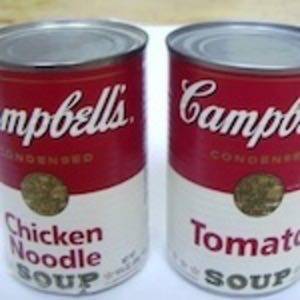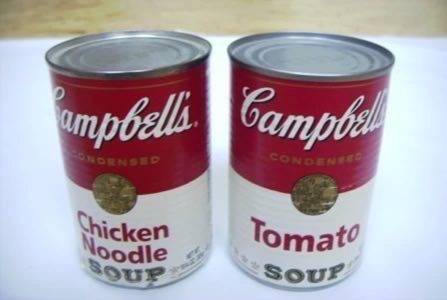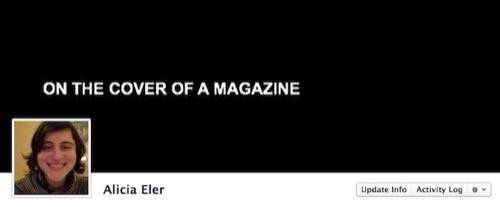Facebook is about liking things. And so is pop art. The two should really get to know each other.

The experience of logging onto Facebook is like no other – it is like feeling one’s way through a black hole of non-linear time and space, plunging through other peoples’ memories and ideas. “Let’s do the time warp” doesn’t really explain what the Facebook experience feels like. “And the ad business still isn’t sure what to make of Facebook,” writes AllThingsD. “Grand new marketing paradigm, or a collection of 800 million people who don’t seem very interested in clicking on ads?”
Are people clicking on Facebook ads? Such advertisements on Facebook sometimes feel more like those strange banner ads on public transportation than the more alluring targeted advertisements. I’m talking about ads on the train, the ones that you gaze at when you’re dead tired and just want to zone out, but you can’t. Those ads are there, staring back at you. Or maybe Facebook ads are more like pop art, culled from the banal, the commercial, memory and the everyday. They want you to like them, like, a lot.

Take this “Get Out of Debt with Siegel” ad on a dirty packed train car. You see it on the Chicago Red Line, a train that traverses almost the entire city – from the north side to the far south, passing steel buildings and open lots and fast cars. This train pauses for less than one-minute intervals to open its doors, swallowing in a new stampede of directionless people. It chugs on to the next stop, pausing only in an emergency. What better space to experience a late-night infomercial?
Another writer described the experience of logging onto Facebook as entering Grand Central Station. It’s a space that’s ripe for advertisements. She felt deluged by friends, and has since defriended down to a lean number of 250, keeping mostly closer friends and family members. Doing this makes Facebook feel more like a neighborhood get-together and less of a visit to one of the busiest train stations in the United States. Facebook ads appear in what feels like a busy train station, perhaps.
Facebook is still “feeling its way around the ad business.” Yet it did happen to sell more than $3 billion worth of ads last year. It’s probably because such ads operate on the simple idea of liking something. It’s something that Andy Warhol knew quite well.
Facebook and The Laws of Pop Art
“Anything you can post on a page, you can turn into an ad,” says Facebook. The content becomes easier to see as more users keep liking it. Advertisers receive the same sort of instant gratification as the ready and willing Facebook users. Everyone likes, everyone wins – at least, in a superficial sense. We become advertisements of ourselves, looking into a virtual mirror.
Facebook’s ad strategy reminds me a lot of the concept behind pop art. In 1963, Andy Warhol said that one day everyone would be world-famous for 15 minutes. Reality TV and viral YouTube videos have made that happen, stretching those 15 minutes to perhaps 15 intense hours on the Internet. On Facebook, that idea becomes a reality even moreso because time is not linear, and fame happens within smaller sub-niches – so 25 people might be having their 15 minutes of fame at the exact same time.
The social media celebrity is different than more traditional ideas of pop culture celebritydom that one witnesses at the Grammys, for example. Today everyone will be famous to 15 people, for 15 minutes. It’s the experience of pop art concepts on Facebook. Or maybe it’s Facebook pop art. Let’s examine.
Here’s the Warhol version of pop art:

The actual soup cans, sans Warholianism:

The Facebook ad version of pop art? Insert your idea here. Just make sure it’s commercial enough to stick.

Facebook’s Pop Art Ad Strategy: You Will Like This
Warhol produced Campbell’s Soup Cans in 1962. He took an everyday consumer culture object and silkscreened its image onto a canvas. Pop art was born.
Facebook doesn’t take ads and make them into art – but an artist could easily do that, calling it Facebook Pop Art. That artist could take a Facebook ad, paint it onto canvas and display it in a gallery. Too easy? Are you ready to like it? This could work. Except advertising on Facebook doesn’t make complete sense.
ReadWriteWeb’s Dave Copeland reports that the 845 million Facebook users that the company claimed in its IPO filing may not actually be quite accurate. Not surprisingly, 6% of those accounts may be fakes and another 5% may just folks who have downloaded the Facebook mobile app, which runs in the background (and might be collecting data from your text messages).
Does advertising on Facebook make any sense at all? Or, rather, do pop art concepts make sense? Yes of course – if you want people to like you/it/the product, that is. And like they will. And here, you are the product, completing the cycle of personalized advertising. All you have to like is yourself.
“The only number an advertiser cares about is the number of prospective customers it can reach — and what it takes to get them to buy whatever it is the advertiser is selling,” Marty Levine, executive vice president of product development at Prosyna Inc., told ReadWriteWeb.
Being an “active user” on Facebook – and other networks, for that matter – is kind of like being a passive consumer, roaming about on Facebook with no real purpose. It is like strolling the streets taking photos with the Instagram app, and uploading them with no prior thought or consideration. It is strolling along, uploading things you like to Facebook, where social media pop culture lives.

Facebook becomes a magazine. You put yourself on the cover of a magazine and then people like you. Or they just catch glimpses of you on Facebook. Either way, you’ve made the magazine, you’re in the public eye.
Pop art is about liking things. Facebook advertisements are about liking things. And the more users like an idea, a status update or an image, the more advertisers know about them. In this pop art Facebook landscape, however, what does a like actually mean? It might be little more than a clever, passive verb. It is easy to digest, it is light and it hardly means a thing. It is something that you like.
If you have ideas for the Facebook version of a pop art ad might look like, leave a comment below.
Images via Wikimedia Commons and INeedToStopSoon.com.










